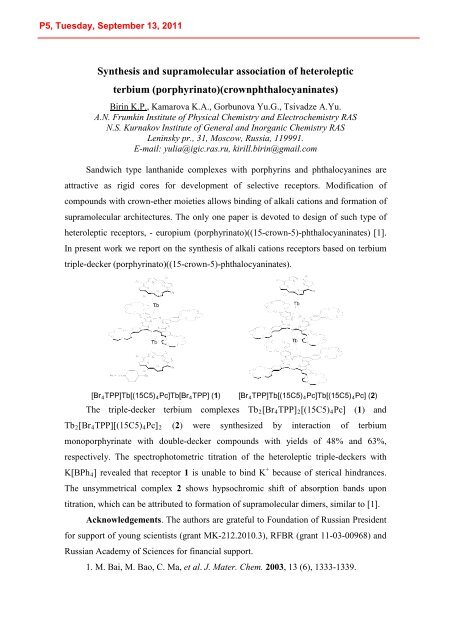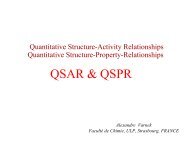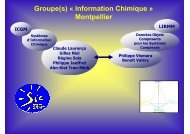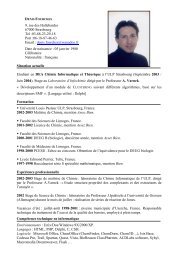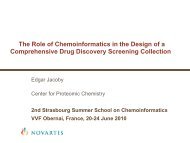International Summer School PROGRAM - Laboratoire d'Infochimie ...
International Summer School PROGRAM - Laboratoire d'Infochimie ...
International Summer School PROGRAM - Laboratoire d'Infochimie ...
Create successful ePaper yourself
Turn your PDF publications into a flip-book with our unique Google optimized e-Paper software.
Synthesis and supramolecular association of heteroleptic<br />
terbium (porphyrinato)(crownphthalocyaninates)<br />
Birin K.P. , Kamarova K.A., Gorbunova Yu.G., Tsivadze A.Yu.<br />
A.N. Frumkin Institute of Physical Chemistry and Electrochemistry RAS<br />
N.S. Kurnakov Institute of General and Inorganic Chemistry RAS<br />
Leninsky pr., 31, Moscow, Russia, 119991.<br />
E-mail: yulia@igic.ras.ru, kirill.birin@gmail.com<br />
Sandwich type lanthanide complexes with porphyrins and phthalocyanines are<br />
attractive as rigid cores for development of selective receptors. Modification of<br />
compounds with crown-ether moieties allows binding of alkali cations and formation of<br />
supramolecular architectures. The only one paper is devoted to design of such type of<br />
heteroleptic receptors, - europium (porphyrinato)((15-crown-5)-phthalocyaninates) [1].<br />
In present work we report on the synthesis of alkali cations receptors based on terbium<br />
triple-decker (porphyrinato)((15-crown-5)-phthalocyaninates).<br />
[Br4TPP]Tb[(15C5)4Pc]Tb[Br4TPP] (1) [Br4TPP]Tb[(15C5)4Pc]Tb[(15C5)4Pc]<br />
(2)<br />
The triple-decker terbium complexes Tb2[Br4TPP]2[(15C5)4Pc]<br />
(1) and<br />
Tb2[Br4TPP][(15C5)4Pc]2 (2) were synthesized by interaction of terbium<br />
monoporphyrinate with double-decker compounds with yields of 48% and 63%,<br />
respectively. The spectrophotometric titration of the heteroleptic triple-deckers with<br />
K[BPh4] revealed that receptor 1 is unable to bind K +<br />
because of sterical hindrances.<br />
The unsymmetrical complex 2 shows hypsochromic shift of absorption bands upon<br />
titration, which can be attributed to formation of supramolecular dimers, similar to [1].<br />
Acknowledgements. The authors are grateful to Foundation of Russian President<br />
for support of young scientists (grant MK-212.2010.3), RFBR (grant 11-03-00968) and<br />
Russian Academy of Sciences for financial support.<br />
1. M. Bai, M. Bao, C. Ma, et al. J. Mater. Chem. 2003, 13 (6), 1333-1339.


